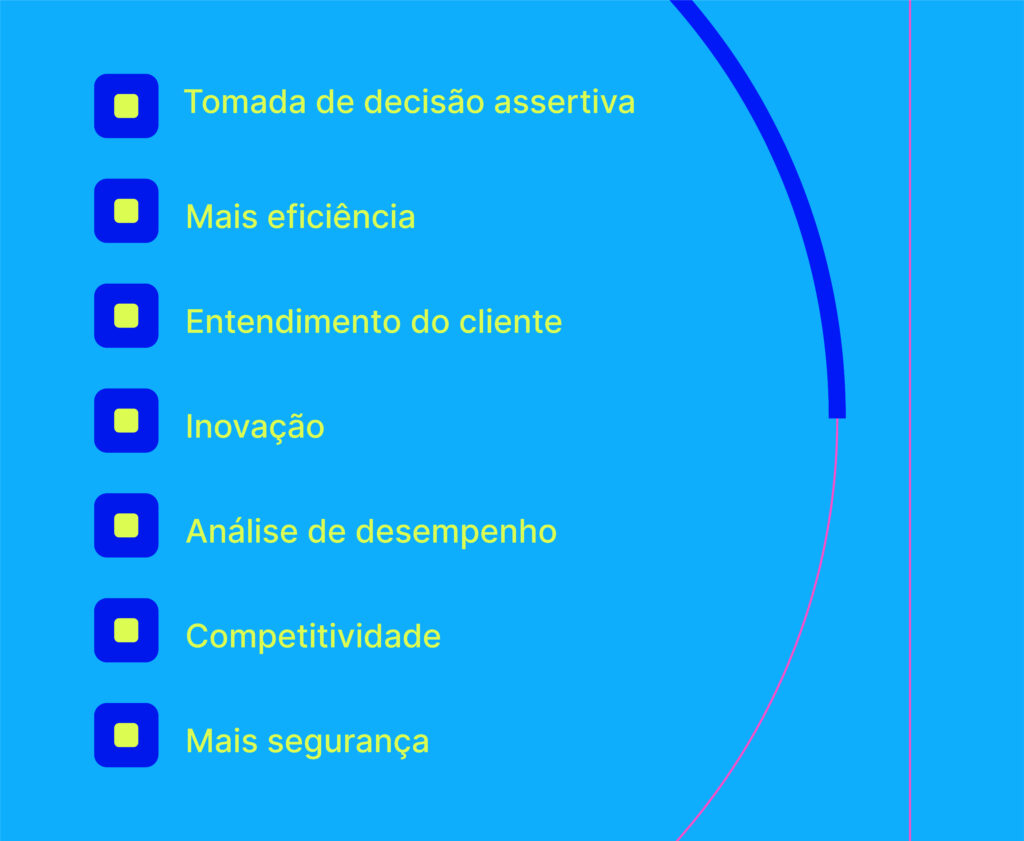We live in an era where information is a valuable asset , and the ability to navigate this sea of data has become essential for business success.
Given this scenario, the Data Driven culture in companies is a true revolution that is redefining the way they operate, decide and prosper. An approach that not only responds to market demands, but anticipates trends , identifies opportunities and drives innovation .
A study carried out by Harvard Business Review found that out of 1,000 companies interviewed, around 48% stated that they managed to reduce costs by introducing a data-driven culture into their business.
Thus, throughout this article, we will delve into all the nuances of the Data Driven culture in organizations – going through strategic data collection, the importance of quality in analysis, and, above all, how this culture can be the key to unlocking the most potential of your business.
Stay with us!
What is Data Driven?
“Data Driven” is an approach to decision-making based on analysis and objective data In the organizational context, being Data Driven means that companies' decisions need to be based on quantifiable and relevant information, instead of relying solely on intuition, guesswork or isolated experience.
In a Data Driven culture, organizations value and use data in all aspects of their operations. Everyone, from leaders to day-to-day employees, uses quantifiable information to understand performance, identify opportunities and face challenges.
This culture is not just about collecting lots of data – but also about how it is used . It involves promoting curiosity to explore information, making informed decisions, and constant learning based on insights generated from data .
In short, assuming a Data Driven culture is like transforming your team into “super detectives” who use clues (data) to guide the company in the right direction.
How did the Data Driven culture emerge?
Data Driven culture emerged in the 1950s and 1960s, with advances in computing and data processing. During this period, companies began to adopt computer systems to store and manage information.
Thus, in the 1980s, database systems and Business Intelligence (BI) began to gain prominence, allowing for more advanced analysis .
The internet boom of the 1990s and 2000s brought a massive influx of data, giving rise to the term “ big data ”. In this way, companies began to recognize the strategic value of data and invest in specialized technologies and talent. The rise of companies like Google and Amazon , which base their decisions on data, has also influenced the Data Driven culture.
Finally, the last decade has seen the proliferation of advanced analytics, artificial intelligence , and machine learning . Today, Data Driven culture is an integral part of modern business strategies, enabling organizations to make more informed and agile decisions.
And it's no wonder: according to data from a Gartner survey, in the last three years, more than 90% of the total data in the world , which represents millions of terabytes stored.
What are the advantages of Data Driven culture for companies?

The Data Driven culture is essential for companies, providing an approach guided by tangible information and objective analysis. By basing decisions on data, they can gain insights into customer behavior, operational efficiency and market trends.
Check out, below, the main advantages of this culture that increasingly drives companies around the world:
Assertive decision making
Being Data Driven allows companies to make decisions based on measurable data. much more assertive decision making . This approach leads to better results in terms of achieving business goals and overall objectives.
More efficiency
One of the great advantages of this culture is the improvement in operational efficiency . Using indicators and metrics, companies identify areas in their operations that require improvement. This way, it is possible to allocate resources more efficiently, increasing profitability and reducing unnecessary costs.
Customer understanding
Data collection and analysis can provide valuable insights into consumer behavior and preferences. This allows companies to adjust their sales and marketing strategies to better meet customer expectations and increase satisfaction.
Innovation
The Data Driven culture stimulates innovation by providing insights for the development of new products and services. This way, companies can identify market opportunities, anticipate trends and stay ahead of the competition.
Performance Analysis
Metrics allow companies to evaluate the performance of their strategies and identify areas that can be improved . Therefore, the use of metrics and performance indicators helps organizations measure their progress against business objectives and adapt their strategies as necessary.
Competitiveness
Companies that adopt a Data Driven culture often become more competitive. They can react quickly to changes in the business environment, anticipate market needs and maintain a strategic advantage.
More security
Data analytics can also contribute to cybersecurity and regulatory compliance. Companies can monitor suspicious activity, protect sensitive data , and ensure they comply with industry-specific regulations.
The pillars of Data Driven culture in organizations
The fundamental pillars of a Data Driven culture in organizations rest on the vital interconnection between people , data and technology .
In this way, they make up the backbone of an information-driven approach and are interdependent, each playing a crucial role in building a mindset that values informed decision-making. See each of them below:
People
People play a central role in this scenario, being the catalysts who interpret and apply insights from data. A Data Driven culture requires not only awareness, but also the development of analytical skills and a data-driven mindset at all levels of the organization.
Therefore, commitment and the ability to collaborate between teams are essential for the Data Driven culture to flourish, promoting assertive decision-making.
Data
At the same time, data is essential to this culture, representing the raw material that feeds analyzes and generates knowledge. Data quality, integrity and security are crucial aspects to ensure that the information extracted is reliable and relevant.
Effective data management involves ethical collection , efficient storage and implementation of practices that ensure compliance with regulations, reinforcing the reliability of the decision-making process.
Technology
Finally, technology provides the infrastructure necessary for large-scale data collection, processing, and analysis. analytics platforms , empower organizations to extract insights .
However, the effective implementation of these technologies requires a strategy that is aligned with organizational objectives, highlighting the importance of a holistic and integrated approach to the success of a Data Driven culture.
What are the stages of Data Driven culture?
Data Driven culture is not just an approach, but rather a three-step journey that empowers companies to not just collect data, but to use it as a strategic resource . In this information-driven world, those who master this art are the true leaders.
From meticulous data collection to strategic storage and finally robust analysis, each step represents a key milestone in organizations' ability to drive informed decisions.
From now on, we will talk about each of these steps, bringing examples and related best practices:
Data collect
The first step in the Data Driven journey is data collection. Here, we are not just talking about numbers; we're talking about identifying and gathering all types of meaningful data.
From transactional data to customer interactions, careful collection is essential. Quality trumps quantity , and the emphasis is on relevant sources and ethical collection practices. This is the starting point, where the foundations of business intelligence are firmly established.
What are the main types of data collection?
There are several types of data collection, each suited to different contexts and needs. Each type of data collection has its own advantages and challenges , and the appropriate choice depends on the organization's goals, context, and the nature of the data.
1. Active Collection
Surveys and questionnaires: Obtains data through direct questions to individuals, customers or interested parties;
Interviews: Involves more in-depth and direct interactions, allowing the collection of qualitative insights;
Feedbacks and opinions: Captures data through opinions and feedback expressed by customers or employees.
2. Passive Collection
Sensors and IoT devices: Automatically captures data through sensors, connected devices and instrumentation;
Online tracking: Records online behavior data, such as clicks, page views and interactions on websites;
Historical records: Collects data without active intervention, such as historical records of transactions, interactions, and events.
3. Third Party Collection
Business partners: Obtains data from business partners and external collaborators;
Data providers: Acquire data from specialized providers offering industry-specific information;
Public Sources: Obtains data from open sources, such as government data, public surveys, and other accessible sources.
4. Social Collection and Digital Media
Social networks: Captures data generated by users on social media platforms;
Sentiment analysis: Evaluates public sentiment towards specific products, services or topics on social media and other online channels.
5. Collection of Logs and Records
Server and application logs: Records detailed information about the performance and behavior of systems and applications;
Event Logs: Captures data from specific events, providing insights into activities and operations.
6. Transactional Data Collection
Commercial transactions: Records data related to financial transactions, purchases and sales;
Customer Records: Captures information about specific customer interactions and transactions.
Data storage

Collecting is only half the journey. In this way, strategic storage comes into play to preserve the value of this collected data. It's not just about accumulating gigabytes; it's about storing them efficiently, safely and affordably.
Therefore, this stage involves careful infrastructure choices, ensuring that data is ready to be called upon when needed. At this stage, we transform data into assets, ready to be used as a strategic compass.
What are the main types of data storage?
The choice of storage type depends on the nature of the data, performance requirements project scale specific analysis needs Organizations often opt for a combination of these solutions to address different aspects of their Data Driven strategies.
Hard Disk Storage (HDD)
- Uses magnetic disks to store data;
- Greater storage capacity compared to other types;
- Used for long-term storage and backups.
Solid State Storage (SSD)
- Based on flash memory technology;
- Provides faster access to data compared to HDD;
- Generally used to improve performance on systems that demand speed.
Cloud Storage
- Uses resources from remote servers accessible via the internet;
- Examples include AWS S3, Google Cloud Storage, and Microsoft Azure Blob Storage;
- Offers scalability, remote accessibility and shared resources.
Relational Databases
- Uses relational database management systems, such as MySQL, PostgreSQL, Oracle and SQL Server;
- Organizes data into tables with predefined relationships;
- Suitable for structured and relational data.
NoSQL Databases
- Includes different types, such as document banks (MongoDB), key-value (Redis), graphs (Neo4j) and column families (Cassandra);
- Designed to deal with unstructured data, without fixed schemas.
Data Warehouse Storage
- Designed for analyzing large data sets;
- Examples include Amazon Redshift, Google BigQuery, and Snowflake;
- Ideal for complex analytical queries.
In-Memory Storage
- Stores data in RAM for faster access;
- Examples include Redis and Memcached;
- Suitable for cases that require low latency.
Data Lake Storage
- Stores large volumes of raw data in its original form;
- It can include structured, semi-structured and unstructured data;
- Generally used for advanced analytics and big data.
Blockchain Storage
- Distributes data across a decentralized network, using an immutable structure;
- Generally associated with cryptocurrencies, but also applied to secure records and transactions.
Data analysis
Finally, we come to robust analysis, the stage where the real magic happens. Using advanced tools, algorithms and technical expertise, data analysis transforms seemingly random numbers into revealing narratives .
Thus, it is at this stage that companies discover insights that guide business strategies. It's not just about data; it's about what this data can tell you and how it can drive innovation and market leadership.
What are the main types of data analysis?
Within the Data Driven culture, data analysis encompasses several approaches to extract meaningful insights Each type of data analysis offers different perspectives, and the choice depends on the specific objectives of the analysis and the characteristics of the available data.
1. Descriptive Analysis
Focuses on summarizing and describing fundamental characteristics of data. It uses descriptive statistics, such as means, medians and standard deviations, as well as graphs to visualize patterns and distributions. This type of analysis seeks to discover what happened .
2. Diagnostic Analysis
It focuses on understanding the causes and reasons behind a particular phenomenon or problem. The main objective is to identify patterns, relationships and factors that contribute to a specific situation. This type of analysis seeks to discover why it happened.
3. Predictive Analytics
It uses statistical models and algorithms to make predictions about future events based on historical patterns. This is crucial for proactive decision-making and future-oriented strategies. This type of analysis seeks to discover what could happen .
4. Prescriptive Analytics
It goes beyond forecasting and recommends specific actions to be taken. It uses advanced modeling techniques to optimize decisions and drive operational effectiveness. This type of analysis seeks to discover what to do .
After all, how can I apply Data Driven culture in my company?
Implementing a Data Driven culture, especially in companies that are not used to this approach, can be a challenging . It requires a holistic approach that permeates the entire organization, from leadership to employees.
Thus, it is an ongoing process that requires long-term commitment. Check out some tips below that will put your company on the path to making the most of the potential of data and driving success:
Set clear goals
First of all, Data Driven culture is a tool . Therefore, identify the goals you want to achieve with it. They can be improving decision making, increasing operational efficiency, improving the customer experience, among others. The important thing is to be clear about where you want to go
Engage leadership
Leadership must be committed to change. Leaders need to understand, once and for all, the value of data, promote a Data Driven mentality and support initiatives that encourage the use of data in all areas , from end to end.
Prioritize data competency
Empower your team to be Data Driven. Provide training and development to equip employees with the data analysis skills This may include workshops, online courses, and relevant certifications.
Invest in infrastructure
Ensure that your company has the technological infrastructure to collect, store and analyze data effectively. This may involve the implementation of data management systems, data visualization , analysis tools and cloud storage, among others.
Establish metrics
Define performance metrics and key performance indicators (KPIs) aligned with your business's strategic objectives. How will you measure your success on this journey? This definition allows you to track progress and evaluate the impact of initiatives.
Test, test, test!
Encourage experimentation and continuous learning. Enable your employees to test new approaches based on data and learn from the results, including accepting failures as learning opportunities.
Evaluate and adjust (constantly)
Conduct frequent reviews to measure progress and identify areas for improvement. Be willing to adjust strategies as needed to better meet the culture’s—and your company’s—goals. After all, learning is constant here!
4 statistics that prove the benefits of being Data Driven
Want more evidence that a Data Driven culture is the path to success for companies? Check out four statistics below that make it clear how this approach can improve an organization's performance and efficiency.
- According to data from North American Forrester , data-driven companies are witnessing an average growth of 30% per year ;
- A G artner study showed that 80% of companies are embarking on data literacy/training programs ;
- According to the Mckinsey Global Institute , Data Driven organizations are 23 times more likely to acquire customers, 6 times more likely to retain customers, and 19 times more likely to be profitable;
- A survey by BARC Research interviewed a number of companies and found that those using Big Data saw an 8% increase in profit and a 10% reduction in costs .
The future of Data Driven culture
that the Data Driven culture has a promising future – with significant advances mainly in the areas of artificial intelligence (AI), machine learning and predictive analysis. As companies seek competitive advantage , adopting this culture becomes essential for decision-making based on data and insights .
A key aspect of this future is the expanding use of machine learning, which allows algorithms to “learn” from large amounts of data and improve their predictions over time.
Therefore, machine learning is a crucial part of predictive analytics, especially in sectors such as finance, healthcare and logistics, where making data-based decisions is key to increasing efficiency and reducing costs.
The proliferation of AI also plays a vital role in the future of this culture. AI and Data Driven are complementary , as AI is powered by data to provide useful insights and automate processes, improving the quality of decisions and increasing business agility.
Some emerging trends in the field of Data Driven include:
- Integration between different data sources , creating a richer and more connected environment for analysis;
- The increase in the speed and efficiency of analysis processes, made possible by the use of advanced tools and AI techniques;
- The democratization of access to data and analysis, allowing a greater number of people to make data-based decisions.
Importantly, as the Data Driven culture evolves, it is crucial to put ethics and data privacy at the forefront, ensuring that personal information is protected and that analysis is carried out responsibly.
Conclusion
By embracing the Data Driven mindset, your company can optimize operations, enhance the customer experience, identify growth opportunities and stay ahead of market changes.
But for all of this to happen efficiently and safely, you need a technology partner who specializes in providing your customers peaceful sleep
That's why the Skyone offers advanced tools in integrations, API, data extraction and storage, and more to help your business transform information into insights . Count on a cutting-edge team to help your company on its Data Driven journey. Find out how we help you reach new levels of efficiency, innovation and sustainable success!





